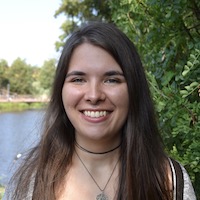Amelie Wenz joins the research group as new PhD Student
3 Jul, 2021

We welcome Amelie Wenz who recently started as a PhD Student in our group!
What is your education, and what have you done earlier in your career?
I started my education by studying Biological Science at the University of Konstanz in Germany. Here, I did my Bachelor thesis project in the field of molecular genetics, in a group focusing on the regulation of the cell cycle and the segregation of chromosomes in vertebrates. After obtaining my Bachelor`s degree, I decided to move to Uppsala in 2016, to obtain a Master´s Degree in Forensic Science at Uppsala University (UU). Thanks to my Master´s Program I was able to start and finish my thesis project at the group of Anneli Julander at the Institute for Environmental Medicine at the Karolinska Institute. My Master thesis project dealt with skin permeation and sensitization of cobalt nano- and microparticles, which was studied, using a diffusion model, ICP-MS and several cell-toxicity tests. Once I was finished with my Master’s Degree, I decided that it would be good to gain more work experience, so I worked for 9 months as a research assistant in the group of Xingqi Chen (IGP, UU). Here, I came in contact with ATAC-sequencing, a method to gather information about open chromatin regions in a genome, as well as Nanopore sequencing, a third-generation sequencing technique. After my stint at the research group of Xingqi Chen, I switched to the research group of Christer Betsholtz (IGP, UU). Under the supervision of Michael Vanlandewijck, I researched on Alzheimer Disease models using immunofluorescence stainings, confocal microscopy and single cell RNA sequencing to examine the Alzheimer´s pathology in the brain vasculature. And now I am here!
What is your PhD-Project about?
The key method that will be used in my PhD project is the image-based morphological profiling of cells, more specifically the cell painting assay. The cell painting assay is a method in which different cell components can be visualized and potential morphological changes can be analyzed. The goal of my thesis now is to this to develop an automated method for drug discovery in precision cancer medicine and multiple sclerosis.
What do you hope to achieve during your stint at the Pharmaceutical Bioinformatics Group?
First and foremost, I would like to gain a deeper knowledge of the techniques and methods that this group have to over, namely high throughput microscopy, morphological profiling as well as lab automation. I also hope that I will grow as a person/ scientist in this group by learning how to become a more independent scientist, by getting to know the field of drug screening and also by working in a very interdisciplinary team. It would also be nice to obtain a PhD-degree while doing so.
Do you have any hidden talents?
When I was 15 years old, I started learning the drums and continued taking classes for a few years. I still like to play them from time to time, which can be difficult due to the noise this hobby creates. I also started to pick up some photography skills and now like taking pictures, mostly of nature. Since I also have quite a big sweet tooth, I really enjoy baking, preferably cakes with a high chocolate content. I don´t know if this is a talent, but I also have a slight obsession with reading and watching documentaries, especially ones dealing with true crime cases. That means I always have a bunch of random facts to offer for anyone that’s asking.

